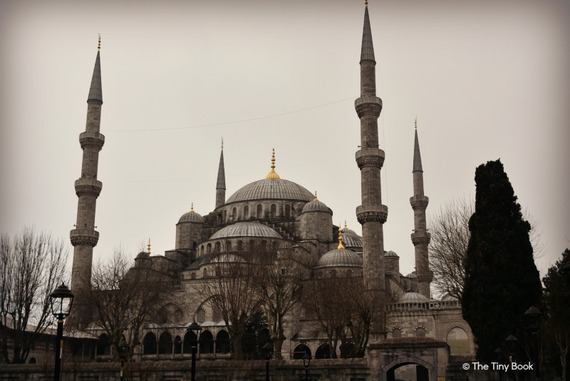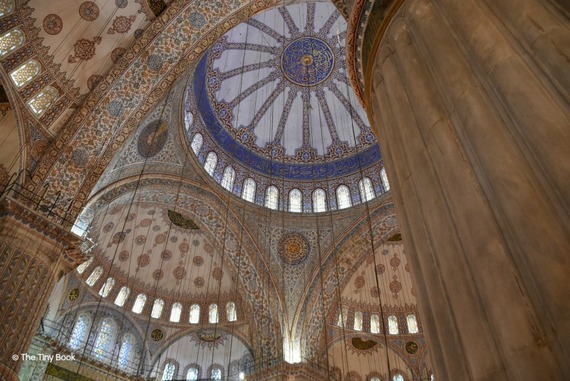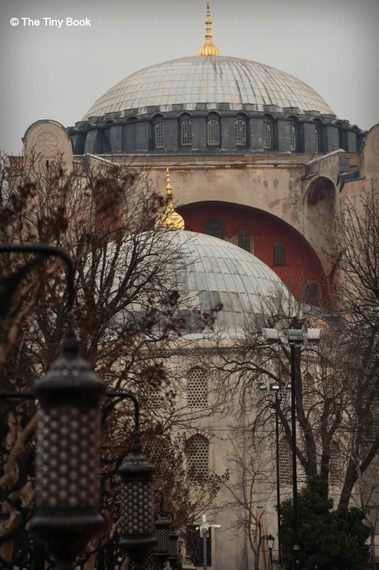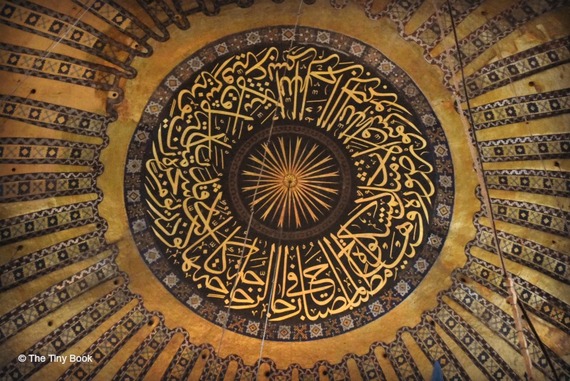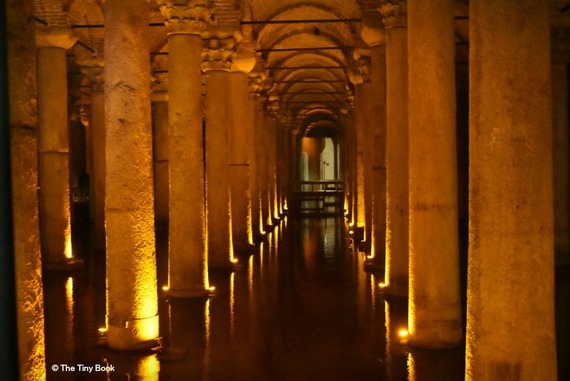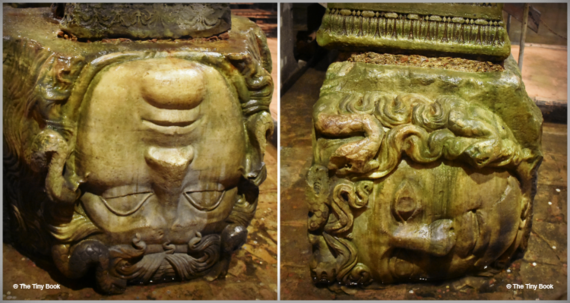The Blue Mosque, Hagia Sophia and the Basilica Cistern: A Triangle of Peace
From the window of my room, not far from Sultanahmet Square, I can hear two melodies early in the morning. Distant seagulls and the call of the muezzins. Sitting by the window, sipping a Nescafé
I can't wait to go outside and get myself lost in the city. A city with a holy soul that I want to discover; a triangle of peace that I want to delimit at my own pace. I leave the hotel and face the cold, cloudy morning. I'm looking for the Holy Soul of Istanbul.
Time goes by with a different rhythm; it's easy to feel. Once outside, my footsteps turn heavy, I want to take in every bit of my surroundings. Observe them, remember and treasure them for ever. I lumber, my walk is slow. I don't want to miss a sight, a sound, a smell. I walk for a while and head to the Hippodrome. The fragrance of roasted chestnuts punches my nostrils. The lights of the dawn fade, giving place to deep cloudy skies.
With a timid attitude I cross the gate. I am in the courtyard of the Blue Mosque. I face its immensity in awe, in wonder. They ask me to move to the side door, the one for visitors. I feel awkward, different. I am aware that I do not belong to this place. Even my jeans are too tight. I must wear a kind of home-made skirt to cover my Occident. I take off my boots and the cold tiles freeze my feet. Off I go, small as I feel, I falter through a tiny passage into the blue immensity of light.
The Blue Mosque
(Built from 1609-1616)
Sultan Ahmet Cammii is also known as the Blue Mosque due to the blue tiles that cover its walls. The tiles are more than 20.000 and have decorations of over fifty different kinds of tulips. There are five main domes and eight secondary ones. The minarets are six.
More than 200 stained glass windows let the light go inside. Blue and golden shades illuminate the interior paintings. Round low chandeliers are all over the prayer area helping lighten the mosque; even more on cloudy days.
After I shoot all the possible pictures, I feel compelled to take a deep breath and put the camera away. I don' want to see it through a lens any more. I look up for the ceilings, the tiles, the inscriptions, the colors. I watch the walls, the carved woods, the magnificent mihrab. I look around, I look down. The vast carpet under my feet. I wander, there is a spirit chasing me, mesmerizing me, covering me in holy silence. The colors remains impressed on my retina when I close my eyes. I now treasure within me the spiritual immensity of it all.
Hagia Sophia
(Built between 532-537)
As I leave the Blue Mosque, I am hit buy a feeling of immediate regret. Nostalgia strikes within the second. I pass through its gates to reach Hagia Sophia and I already need to go back. See it all again.
In contrast with all the blue I am carrying with me, the reddish walls of the former Church of Sancta Sapientia. Ayasofya, as the Turkish call it. With a past of sufferings and constant change, this building was born as a patriarchal basilica and then turned into a mosque. Now, it is a secular museum. My attention falls on the impressive dome. Grey against the even more grey skies of Istanbul. All four minarets differentiate from each other. I notice the absence of the perfect symmetry of architecture. Differences in style tell the story of its turbulent history. A suggestive Şadırvan (fountain), for ritual ablutions, gets on my way. I cross the narthex and step over an ancient wood sill. I am inside, I am a minimal part of its history.
I do not see the dome from the inside, nor the paintings, nor the splendor. Eight wooden and leather green medallions with golden Arabic inscriptions force my head up. They are names: Allah and Muhammad. The caliphs Abu Bakr, Omar, Osman and Ali, and the two grandchildren of the Prophet.
Then I look down. On the floor, a square area with colored marble pieces. And the Omphalion, the exact spot where emperors were crowned. I'm in the center of the world.
Smells of ancient wood mix with the shine of golden ornaments. I feel an odour of sanctity. Utterly holy feelings. My mouth and eyes remain wide open as I gaze at the ceilings in full astonishment. And there I stand, wondering why on Earth it took me so long to make this trip. Inside a building that has changed the history of architecture. I had heard that assertion many times. Now I know it.
I ascend through an immemorial passage. A ramp that makes me reach the upper galleries. A mixture of faith and religions give me a sense of communion with my lack of faith. Leaving me in an atmosphere of silent introspection. I get a distant look of the ground floors and immensity hits me again. Once again I look up. And down. Golds and greens dominate the scene depicting the magnificence of times long gone. The ceilings are still high. The medallions remain impressive. My soul cannot get back from the vastness of it all. It is infinity. How small we are in this Universe yet how boundless our legacy remains.
In the northern corner of the church, the crying column bears a hole big enough to insert a finger. A mysterious legend surrounds it, this is due to the water that used to come out of it. The miracle of the sweating column. I behave as any tourist and make a wish.
Walking out of the ancient doors, and stepping back into the modern present, the call to prayer takes me by surprise. I hold my breath. The Blue Mosque is calling. Hagia Sophia responds. A never-ending conversation, fascinating and full of thrill. I can stand right here for ages, right in the middle of battles, cultures and crossroads of religions. A metaphor of the city in itself.
Basilica Cistern
(6th century)
I leave Hagia Sophia while the call for the prayer still echoes inside my mind. The weather outside is cold, it rains and it's windy. I walk less than 150 meters, I stop for an elma çayı to heat up, the sweet taste of fresh apples helps me recover from emotion. Little do I know that the best is still to come.
Down the 52 steps slow and careful, I descend into a world of antique wonder with a hex atmosphere to it. As if a spell is about to be cast upon me. I am enchanted, delighted, in a parallel world of emotions.
Dimmed lights show me the way over a wooden platform on water. It's easy to guess fish are swimming beneath, with little effort you can hear them. I pay even closer attention and I see the huge carps swimming in the darkness.
A soft music adds to the ambience. You are not on this Earth, you are inside Yerebatan Sarayı, the Sunken Palace. Yerebatan Sarnıcı, the Sunken Cistern. The biggest of the hundreds of ancient cisterns beneath the former Constantinople. It owes its name to the former basilica that once stood over it: the Stoa Basilica.
This underground refugee is chamber of allure. The lights adorning the columns make the surroundings look particularly warming. I stop several times during my way. My eyes strive to see it all and my soul needs to fill itself with the memory of the place. It will long remain the most adored place in Istanbul for me. I would return to the city only to walk its passages again and again. Writing this piece still brings tears to my eyes. It still touches some inner cord and moves me.
Medusa column bases
I walk searching for the so desired Medusas. I have seen them so many times and in so many pictures, it is my obsession to stand next to them. In the northwest corner, almost at the end of the first part of the wooden passage, the bases of two columns appear in front of me. A crowd divides me from them. I struggle with my patience and wait. After flashes, phone pictures and mundane I-was-here-too portraits, flocks of tourists move on and I finally get a moment for myself. I can look closely, admire the greenish rusted color of the faces. Go back to my mythology recollections and think about their weird position: the Medusa will not harm you if you do not look at it straight, thus negating the power of the Gorgon's gaze. Their origin is unknown and there is no evidence suggesting they had been column pedestals.
The path goes on for some more meters, I find a café and a souvenir shop, both full of artificial lights. Still inside, the magic vanishes. The stairs lead up and I do not look up. I want to keep the memory as it was. The deepest and most touching experience of this trip.
